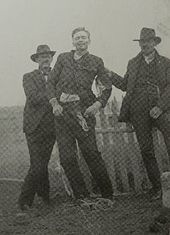Loading AI tools
Ghost town in Coconino County, Arizona From Wikipedia, the free encyclopedia
Canyon Diablo is a ghost town in Coconino County, Arizona, United States, on the edge of the arroyo Canyon Diablo. The community was settled in 1880 and died out in the early 20th century.
The town, which is about 12 mi (19 km) northwest of Meteor Crater, was the closest community to the crater when portions of the meteorite were removed. Consequently, the meteorite that struck the crater is officially called the "Canyon Diablo Meteorite."[2]

The ramshackle camp of railroad workers originated in 1880, due to the construction of the Atlantic and Pacific Railroad bridge over a large canyon named Canyon Diablo. The temporary community assumed the name of the canyon that stood in the way of the railroad construction – Canyon Diablo. The bridge construction took six months. Many regular railroad construction workers were encamped and waiting to recommence their work once the canyon had been spanned. After the bridge was completed, construction resumed and the camp was largely abandoned.[3]
Construction of the railroad normally involved a constantly moving work area. The completed rail was used to transport materials and workers to the next line. The bed was then graded, small bridges were built, and the rail laid down. The workers would camp in tents spread out along the work area depending on the jobs they performed. However, when very large rivers or canyons were encountered, construction of specialized bridges would slow down or stop. This resulted in a larger temporary camp or community springing up as the idle workers consolidated together in one place near where the bridge was being constructed. This is how Canyon Diablo came to be.[4]
The original pillars the bridge was mounted on were excavated from the surrounding Kaibab Limestone and shaped on site by Italian stonemasons. The ruins of the lodgings of the railroad workmen are on the west end of the bridge site. Although the railroad ended at the edge of the canyon, work on the railroad route still progressed. Crews were sent ahead to survey the route, prepare the grade and bed, cut and pre-stage railroad ties and other supplies in advance of the iron rails that would accompany the trains once the canyon was spanned when the new bridge arrived. Work quickly progressed until the A&P crew linked up with the Southern Pacific Railroad crews at Needles, California on August 9, 1883.
Originally a small mobile business community catering to the needs of railroad men, once the railroad stopped at the edge of the canyon this community quickly produced numerous saloons, brothels, dance halls, and gambling houses, all of which remained open 24 hours a day. No lawmen were employed by the community initially, so it quickly became a very dangerous place. Its population was mostly railroad workers, along with passing outlaws, gamblers, and prostitutes. The town was designed with two lines of buildings facing one another across the rock bed main street. The center street, however, was not named Main Street, but "Hell Street". It consisted of fourteen saloons, ten gambling houses, four brothels and two dance halls. Also on this street were two eating counters, one grocery store, and one dry goods store. Scattered about in the vicinity of downtown were large numbers of tents, shotgun houses, and hastily thrown up shacks that served as local residences.
Within a short time the town had 2,000 residents. A regular stagecoach route from Flagstaff to Canyon Diablo began running and was often the victim of robberies. Within its first year, the town received its first marshal. He was sworn in at 3:00 pm, and was being buried at 8:00 pm that same night. Five more town marshals would follow, the longest lasting one month, and all were killed in the line of duty. A "Boot Hill" cemetery sprouted up at the end of town, which in less than a decade had 35 graves, all of whom had been killed by way of violent death. The 36th grave was that of former trading post owner Herman Wolfe, who died in 1899, the only one to have died a nonviolent death.
Herman Wolfe's trading post was at "Wolfe's Crossing" on the Little Colorado River about 12 miles north of Leupp, Arizona and near a place called Tolchaco. Herman Wolfe died there and his body was transported to Canyon Diablo for burial. Currently Wolfe's grave is heavily monumented and the story is that after World War II a relative from Germany found his grave and installed the headstone and other improvements on the grave site.
When the railroad bridge was completed, the town quickly died. The original railroad bridge was replaced in 1900 with a new bridge to carry heavier locomotives and cars. By 1903, the only thing remaining in the town was a Navajo trading post. A new double track railroad bridge was completed across the Canyon in 1947. What remains today at Canyon Diablo are a few building foundations, the grave marker and grave of Herman Wolfe, the ruins of the trading post, a railroad siding and a double track railroad bridge.
Canyon Diablo's population was 30 in 1890,[5] 29 in 1900,[6] and 36 in 1920.[7]
Access to Canyon Diablo is north on a very poor road from Exit 230/Two Guns off Interstate 40. A high ground clearance vehicle is recommended.
Seamless Wikipedia browsing. On steroids.
Every time you click a link to Wikipedia, Wiktionary or Wikiquote in your browser's search results, it will show the modern Wikiwand interface.
Wikiwand extension is a five stars, simple, with minimum permission required to keep your browsing private, safe and transparent.